It wasn’t until that Sunday night of Labor Day weekend—after work, after a fun-filled four-day staycation with one of my best friends, after being sick on and off throughout August—that I finally had a moment to take a deep breath and look at the mountain forecast for Mount Hood.
It looked glorious.
Clear sunny days, low winds, and no precipitation; not too hot and not too cold.
I texted one of my new outdoorsy artist friends to see if she still wanted to come along: “Weather looks good, air quality looks good, fires look good; tired but otherwise my body feels okay, so I’m leaning toward YES!✨🫧💓”
There were still many stars that needed to align for me to get on—and stay on—the Timberline Trail, but I knew that was where I was meant to be.
The longing had been growing since a year ago when I was on my whimsy way road-tripping through the West from August to October, 2023. As I passed through Portland and the Columbia River Gorge, I decided to skip backpacking the Timberline Trail, so I’d have fresh legs for a week-long backpacking and rock climbing trip in Wyoming’s Wind River Range a few weeks later.
Thus, it moved to the top of my bucket list.
And, hovered in the back of my mind and heart all summer long this year. Since I started section-hiking the Deschutes River Trail (DRT) this May after breaking my leg in March, I wondered: Could I do it? Or would I have to wait another year?
Each week at Physical Therapy (PT) this spring we refined my at-home exercises and talked about my progress, but only hinted at the upcoming mountaineering and backpacking season. After I was off crutches and out of the boot by May, I was walking and on my feet all day, multiple days a week at REI, plus regularly bike commuting, practicing yoga, hiking, and camping.
During my PT appointment in late August, I excitedly mentioned that I only had one more DRT section to go before my birthday and the end of summer. My Physical Therapist smiled and noted how much time was still left after that for hiking Broken Top (Elevation: 9,177 feet) or South Sister (Elevation: 10,358 feet).
I smiled back.
Hmmmmm. Or the Timberline Trail.
The Timberline Trail circumnavigates Mount Hood, an 11,249-foot tall dormant volcano, that I first hiked with a backpacking partner in August 2017, then again with three friends in August 2020, then attempted to climb in May 2021, and finally summited in May 2023.
Trailblazed by the Civilian Conservation Corps in 1934, the approximately 40-mile trail—total mileage depending on how often one gets lost and how much one walks around at camp—navigates nearly 10,000 feet of elevation gain and loss as it dips into and climbs out of 11 glacial valleys; crosses five major rivers, plus 25+ minor creek, stream, and brook crossings; and winds through three different ecosystems described by the National Forest Foundation, including:
“a moist, temperate rainforest grows, complete with moss that hangs off the branches of thick Douglas Fir trees” on the west side,
“a dry, fire-adapted forest with stately Ponderosa Pine trees that receives little rainfall” on the east side,
and the extreme cold and strong winds of an arctic-alpine environment at higher elevations above the timberline—its namesake.
Members of the Confederated Tribes of the Grand Ronde and the Confederated Tribes of Warm Springs all have traditional hunting and gathering grounds around the mountain where their ancestors collected plants and berries, caught migrating Chinook and Coho salmon and Steelhead trout, hunted deer and elk, and coexisted with northern spotted owls, cougars, wolves, mountain goats, and other wildlife.
Just like the traditional indigenous medicine wheel echoing the four directions, four seasons, and sacred path of both the sun and human beings as described by the National Park Services, the mountain has four distinct sides.
Each feels like its own world. It's more like hiking a mountain range than just journeying around one peak.
See the whole Timberline Trail 2024 album on Google Photos.
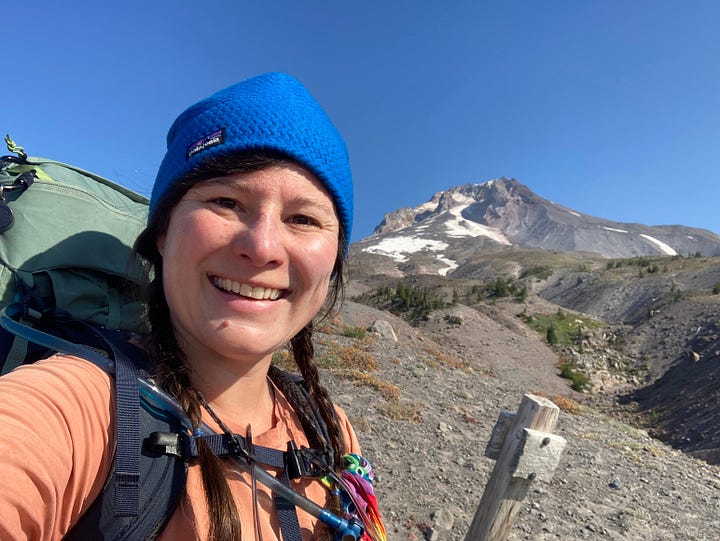
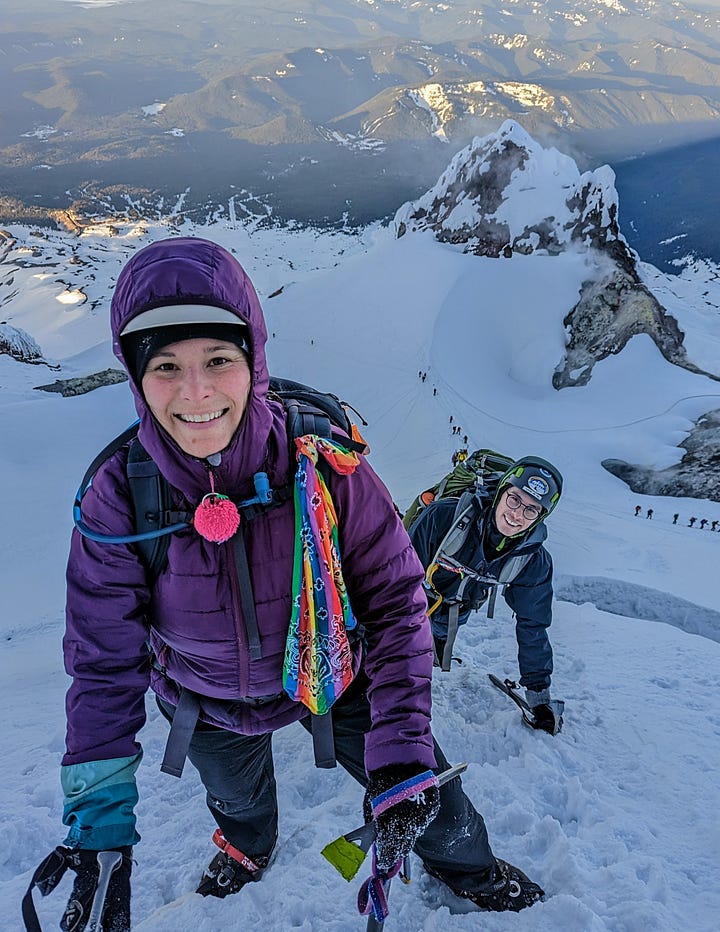
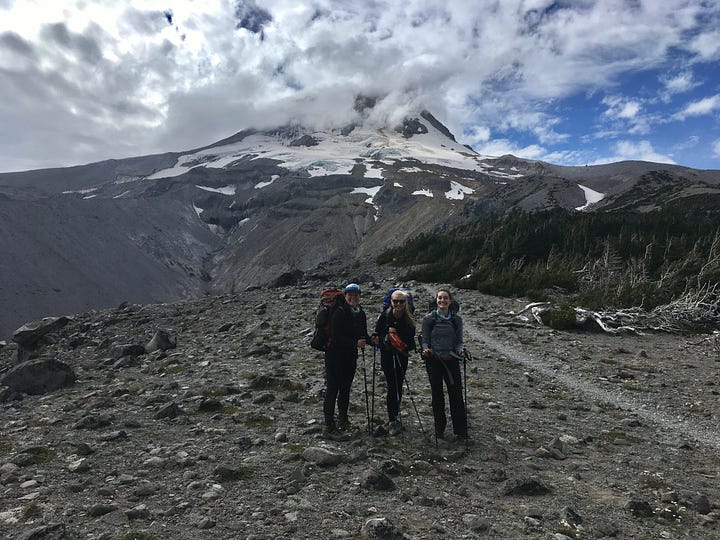
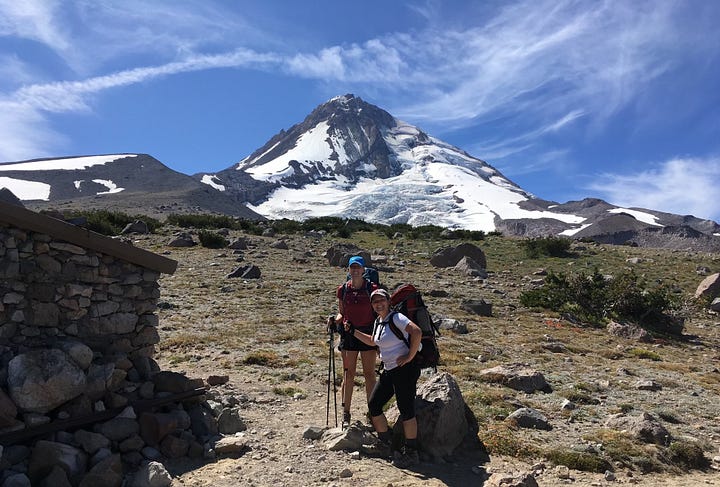
Somehow, all the stars that needed to align in the next 24 hours did—borrowing gear from climbing club friends, canceling PT and spiritual direction appointments that week, getting a shift covered, coordinating trip plans via text all day with my friend, plus packing all morning, then last-minute food and supplies shopping at work that evening—so I had a hiking window from Tuesday to Friday afternoon.
Finally crashing at 11 p.m. on Monday night before waking up to my bird chirping alarm at 5:45 a.m. was a preview of the nights to come. Once I hit the road to Redmond, about 30 minutes north on the way to Mount Hood about 2.5 hours north of Bend, Ore., to pick up my friend and her dog, I texted: “On my way! 6:30 eta”
A few minutes later, a long text message from my friend popped up on my iPhone so I glanced down from the hazy grey sunless sky to scan it. The gist: She was out.
Once I arrived, we talked through several different options, but ultimately agreed it was best for her to call it now. Her heart still said yes as the tears streamed down her face, but for multiple reasons, her body was clearly saying no.
Of course, she would be there with me in spirit—and borrowed gear including a four-inch thick luxury sleeping pad, mini sunblock, bear bag, and rope. The grey had lifted and pink clouds hovered above the horizon as I waved goodbye and drove off into the sunrise.
That’s when it hit me: I was doing this solo.
Three nights, four days in the woods by myself. Something I was totally prepared to do re-following my original 2020 itinerary. After all, this friend had only joined after I mentioned the possible trip at my birthday gathering the week before. But, I hadn’t actually imagined happening.
With a quick gut check, the longing and desire were just as strong so I stuck to the game plan of a pitstop for gas, Starbucks, and bathroom in Madras, Ore., then on to the trailhead at the overflow parking lot of Timberline Lodge where I’d geared up so many times before for skiing when I was a kid and for conditioning climbs with the Mazamas Mountaineering Club in the past few years.
I giggled out loud as I snapped my first selfie with the mountain by the Pacific Crest Trail (PCT) marker, so casually setting out around 10:00 a.m. The first time we nervously slept in the parking lot in the back of my tiny Volkswagen Rabbit, so that we could acclimate to the 6,000-foot elevation and be on the trail by 6 a.m. The second time, we departed around 8:30 a.m. after driving over well-rested from Portland that morning.
Not 20 minutes after setting out down the ashy, sandy trail to White River, I approached a spur trail—a short trail that branches off from a main trail often leading to a viewpoint—and paused to look back at the majestic south face of the mountain that I knew so well, every icy step of the way to the tippy top.
My heart swelled the same way it did earlier that morning when I came around the bend on the seven-mile road winding up to Timberline Lodge from Highway 26 and caught my first close-up glimpse. I’m back home.
I knew this was one of the best profiles of the mountain. So even though I hadn’t broken a sweat yet, I dropped my pack, and pulled out my sketchbook—one of my few heavy, but necessary “luxury” items—and favorite Uniball pen, my foam sitting pad from a past trail angel, and my Starbucks chocolate croissant. No need to carry that weight any longer, I chuckled to myself.
As I nibbled and sketched, I felt the warmth of the sand under my black leggings and of the sun rising into the clear blue sky. A few small birds chirped above and glacial water rushed far below. Seeing the mountain in 3D was so different than drawing from a photo. As if I can feel the energy of this living being.
“Plein air artists capture the spirit and essence of a landscape or subject by incorporating natural light, color, and movement into their works,” noted one art center about its Plein Air Festival.
This was exactly how I wanted to live. And how I wanted to create.
En plein air. In the open air.
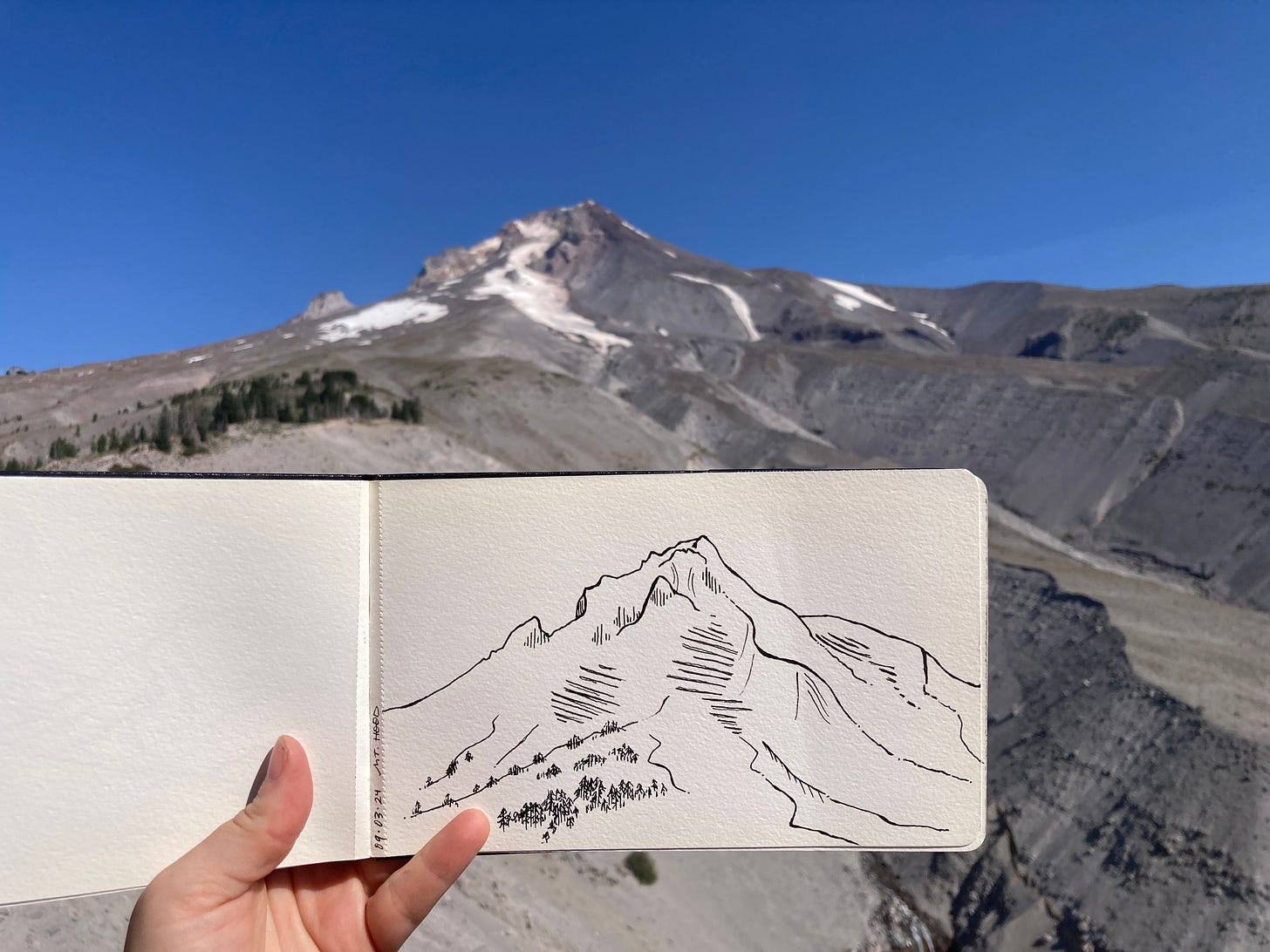
After a pair of hikers and then a solo hiker passed by with quick and surprised hellos—probably wondering why someone lounges on the trail here whether they’ve just started or especially if they’re almost finished—I knew it was also time for me to get a move on.
I didn’t have that many miles to cover in Day One, but I was just savoring the first moments in a literal mountain of beauty that lay ahead so I had a lot more dilly dallying to do.
After steeply descending, then quick and easy rock hops across a couple of different branches in the swift but low river, I reentered the forest and immediately started steeply ascending.
Exactly how I knew this trail—and life—goes. Up and down, all the way around.
I wasn’t quite out of breath, but definitely welcomed a break when I looked up and saw a group of oncoming women step off the trail per hiking etiquette—the winded get the right of way.
A moment later there was an O.M.G.-squeal as the fourth hiker ran over to give me a hug. As we peeled apart and I still couldn’t place her name, she realized that I was actually a doppelgänger of a long lost friend. I laughed it off and reassured her that it happens all the time. Especially with so many kindred spirits on the trail.
I almost turned off Airplane Mode and texted my Dad to tell him “I told you so,” that I would not be alone on the trail. In fact, I’d have to try hard to enjoy nature in solitude when there were so many other humans around.
Soon I rounded the bend where the forest opens wide to wildflower-filled meadows—so that’s what’s under all the snow at Mount Hood Meadows ski resort—and saw the clump of trees where I took a long nap in 2020 while my very fit friends graciously ran back a mile to retrieve my iPhone that I accidentally left on a log when we took a pee break.
It was a fitting spot for lunch, so I took off my boots and ate a Cashew Cookie Larabar. Then I pulled out my foam sitting pad and fleece vest to cushion the ground and tree as I laid down and propped my legs up against the tree trunk like we often do at the end of yoga class to encourage circulation and feeling grounded.
A solid base below us like the sprawling roots of a tree.
Laying there, I remembered my performance anxiety about the hike in 2020. I didn’t know what my body was capable of. Past knee and IT Band injuries in my right leg flared up with dull, aching discomfort the week before we departed and I imagined the worst—that I’d break and need to be rescued from the trail—so even though I planned the trip, I almost bailed the night before. Hence, why my friends offered to retrieve my phone and save my leg any extra miles.
Ironically, we proceeded to hike way ahead of schedule trying to outpace an incoming storm, completing 14-, 19- and 11-mile days respectively and finished an entire day early. I was much stronger and fitter than I thought.
After my quick nap, then a long chat with a couple of day hikers asking about the trail and route, I finally ventured through the rolling alpine meadows with cool, babbling brooks and every shade of local wildflowers.
I squealed when I first spotted my favorites, the truffelumps—which is not actually their name but for some reason is how my mind always remembers the name of “truffula trees” from Dr. Seuss’ classic book The Lorax that look exactly like this wildflower—swaying in the green grasses like a group of young, blond, swoopy-haired Justin Beiber lookalikes.
According to the North Cascades Institute, the seed head of the Pulsatilla occidentalis or Western Pasque Flower is a herbaceous species of flowering plant found at high elevations throughout the West in the U.S. and Canada, and a mouthful which is probably why I can’t remember it.
I practically skipped along the trail to snap close-up photos of the spiky, deep crimson Indian Paintbrushes with the mountain and a heart-shaped cloud in the background. After passing through the ski resort and forested section, I came around the bend to a creek. A little way upstream I easefully crossed a log and continued on to snap the perfect long-exposure Live shot of the magical horsetail waterfall.
I would not have been surprised to see Care Bears sliding down a rainbow in this daydream.
Or a herd of naying goats with little backpacks on.
After being in la la land for a few miles, that’s what my mind remembered first before I knew where I actually was on the map—almost to Newton Creek which was my campsite destination for the evening.
The herd of a dozen goats we encountered in this section of the forest in 2020 was the most wildlife I’ve ever seen on the mountain and we had all agreed was quite a clever way for those hikers to offload all of their gear.
Upon arrival at Newton Creek, which is actually more of a river, I quickly snagged one of several campsites nestled in the trees beside a small creek, which was an excellent water source though difficult to get 200 feet away from to make bathroom facilities.
This was where we camped in 2017 on our last night of the clockwise loop when my feet were too blistered to help my backpacking partner with camp set up or cooking so I just laid in our tent hurting. This was where we didn’t camp in 2020 on our first night of the counterclockwise loop and instead pushed on to established campsites at the north side of the mountain.
I was tired but fully mobile as I changed into dry clothes, set up camp, filtered water from the creek, and awkwardly did stretches inside the small one-person tent while I boiled water to “cook” my dehydrated meal. Knowing I’d have service on this side of the mountain and so excited by my progress, I turned off Airplane Mode to text photos to my Dad and a handful of supportive friends. Oops, my battery quickly depleted to 10 percent so that was enough of that.
See highlights from Day One on the Timberline Trail on Instagram.
Since I thought I’d be in the company of a friend and a dog, I didn’t pack a book to pass the time. Instead, I ate dinner and watched as the orange glow faded into the shadows on the rock cliffs across the river before it was soon time for bed.
Once I snuggled into the comforts of my favorite Big Agnes sleeping quilt and Cocoon hood pillow on my luxury Therm-a-Rest air mattress, I realized that I forgot my ear plugs which are critical for me to actually sleep in the wild. Otherwise, my central nervous system stays on high alert for any sound. Especially next to the constant roar of a river and the trickle of a creek.
Instead of spiraling thoughts outward, I turned inward and took a deep breath. Sighing deeply, I knew this could be a dealbreaker. If I didn’t sleep that night, I might not have the energy to keep going forward past the loop’s midpoint of no return the next day. Thus, the next morning was the only time it would make sense to turn back if needed.
I replayed my perfect first day, wildflower by wildflower, as I tried to rest and reasoned that if that was all I got, well it was wonderful.
There were many stars that needed to align for me to stay on the Timberline Trail, but I knew that was where I was meant to be.
May you believe in yourself this week.
Love,
Jules
Read the rest of the story: The Comeback: Part 2 | The Comeback: Part 3




Your post lights a fire in me to hit the trails again soon! There is nothing like camping solo in such a beautiful landscape. When you're alone, you truly experience EVERY detail of the trail, the animals, and the plants. I honestly can't remember the last time I backpacked with someone else :)
This trail has been on my list for a while, and I plan to do it on future trips back up in Oregon. It must be unbelievably beautiful, with the different environments as you hike along the mountain. Thank you for painting such a beautiful picture with your post.